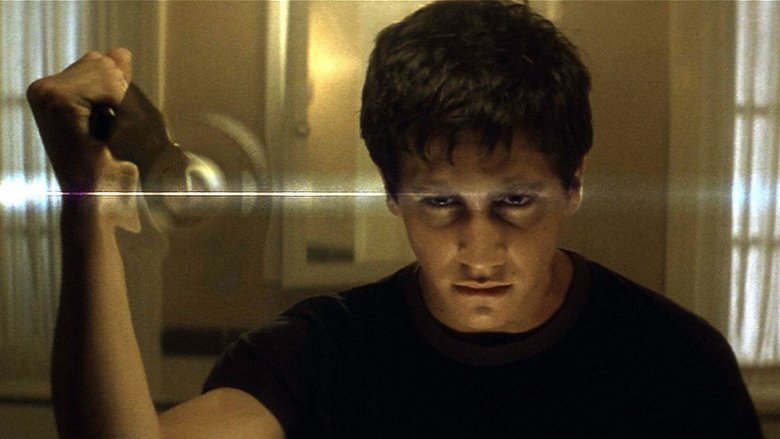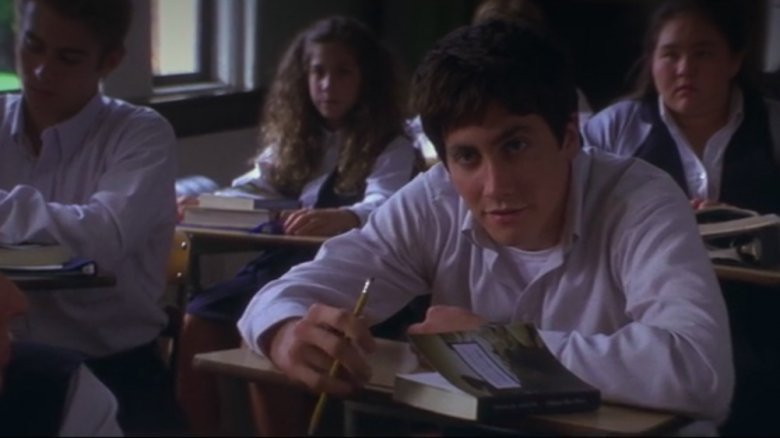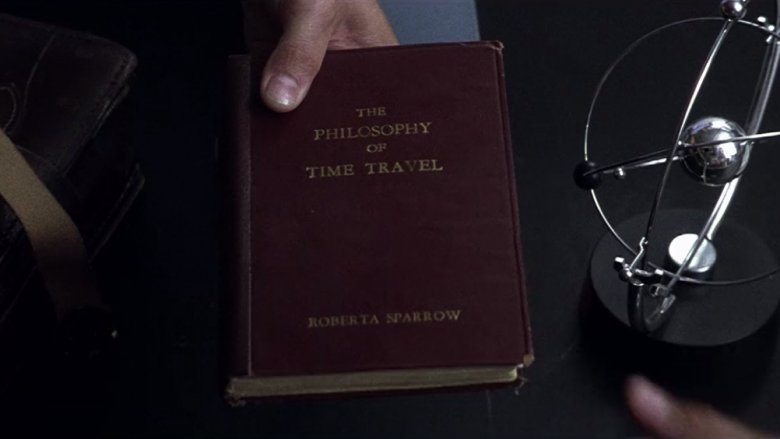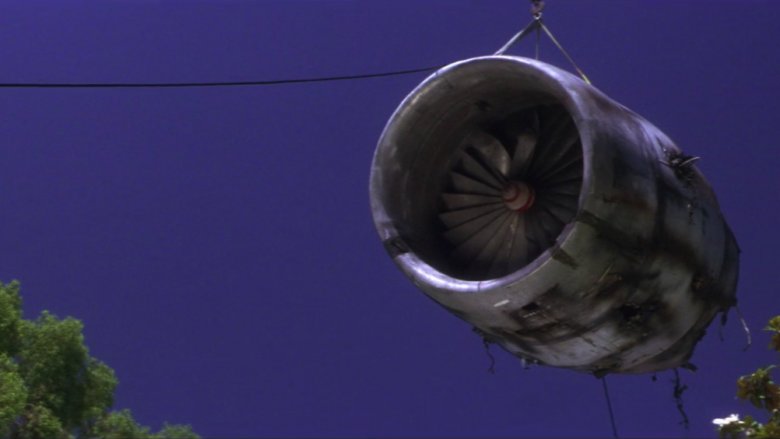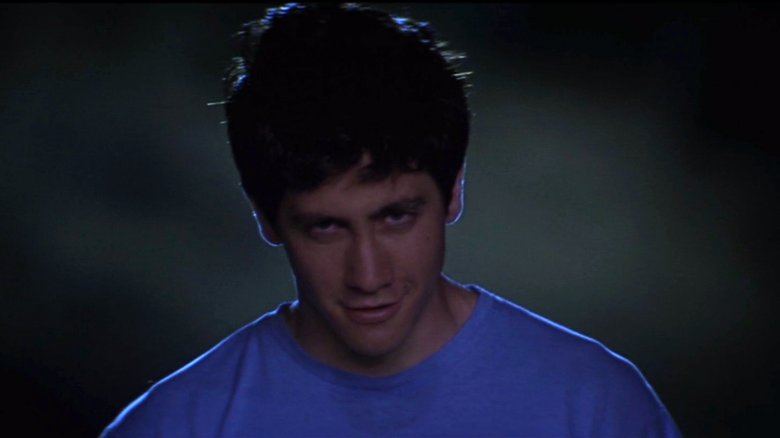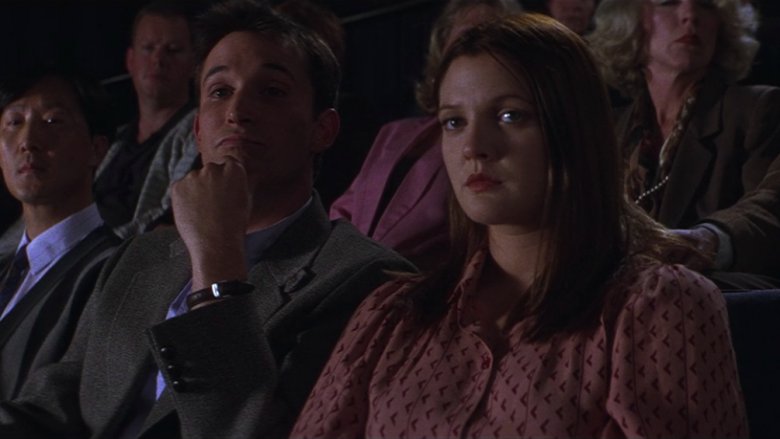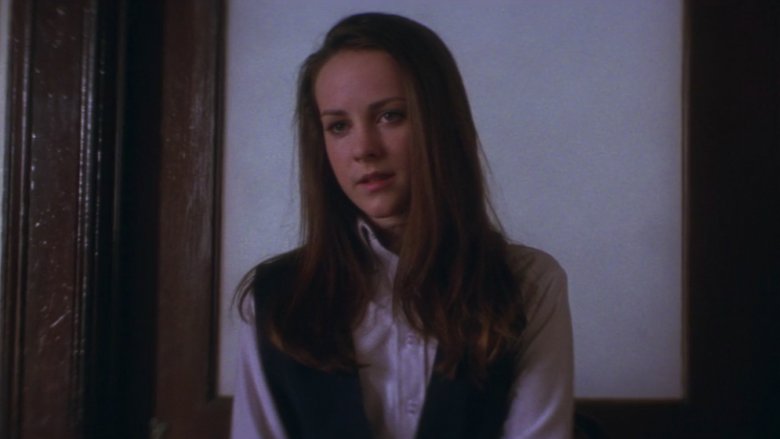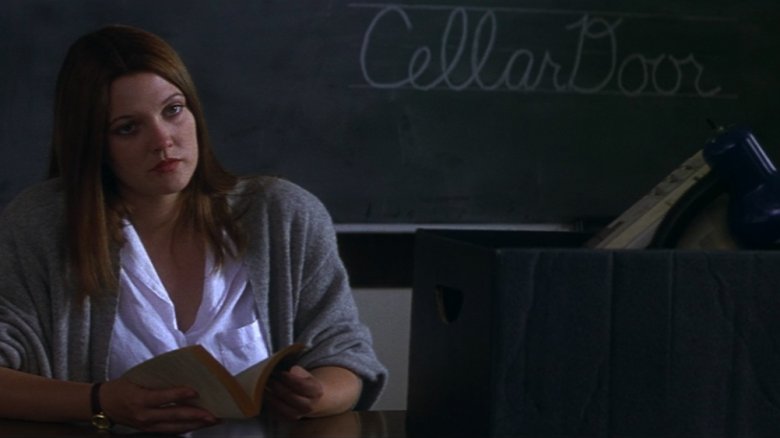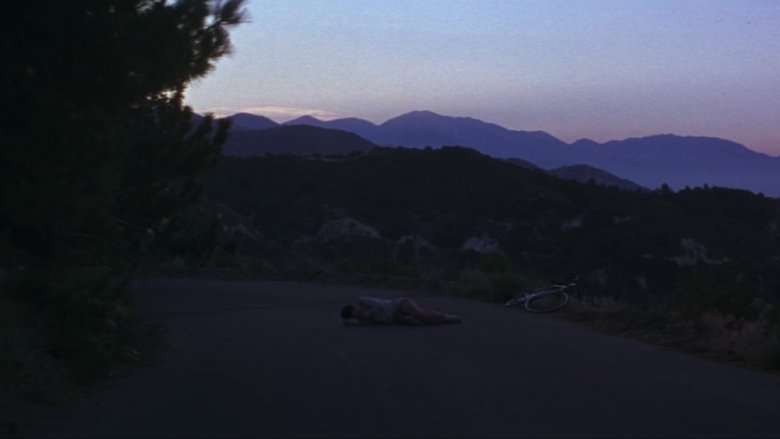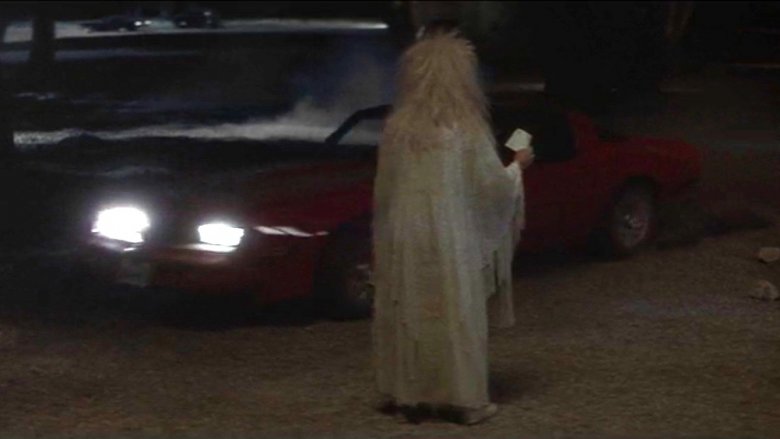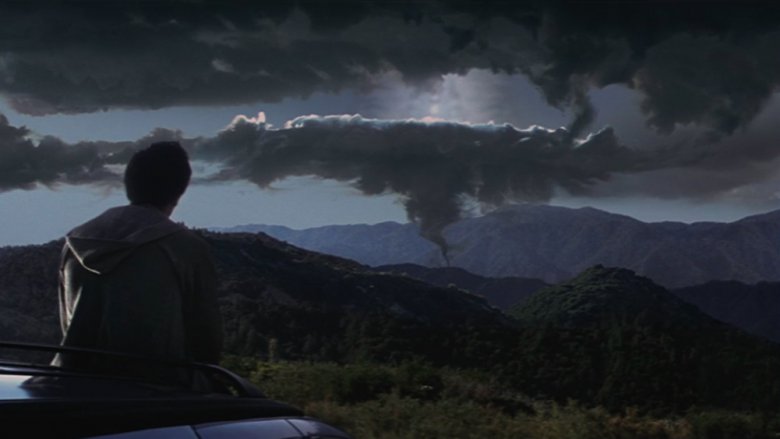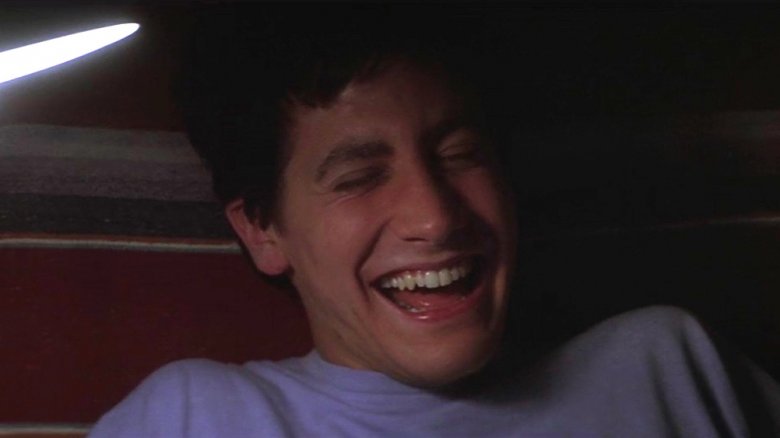Donnie Darko's Ending Explained
Okay, everybody. Quick show of hands — did you understand Donnie Darko the first time you watched it? That isn't a trick question: it's unlikely anyone fully comprehends the magnitude of Richard Kelly's cerebral directorial debut immediately. Like a fine wine, its sickly sci-fi aftertaste takes time to mature. A little research and extra-curricular knowledge is required to piece everything together, and while a Ph.D. in physics isn't necessary, it'll sure help.
Consequently, all these years after its release, debates around Donnie Darko's true meaning rage on. Some elements can be adequately explained, while others are ambiguous and ripe for interpretation. We're here to offer insight on both fronts. Digging into the movie's knotty subtext can only enhance future viewings, and help you proudly and confidently answer the question: "did you really understand Donnie Darko?"
In zero days, zero hours, zero minutes and a few seconds, there will be spoilers ...
A story told on multiple levels
Separating Donnie Darko's deeper meaning from its surface-level narrative is imperative. Superficially, it's the story of wide-eyed and neurotic teenager Donnie (Jake Gyllenhaal), as he struggles to fit in with his peers during his high school years. From the off, Donnie suffers with apparent delusions. Combined with a track record of unruly behavior, regular therapy sessions and medication, it's heavily implied Donnie is suffering from paranoid schizophrenia.
Donnie balances disturbing hallucinations of a six-foot rabbit named Frank with typical adolescent challenges. He dabbles with drugs, drinks, rebels, and falls in love with one of his classmates, Gretchen Ross (Jena Malone). He has a love-hate relationship with his parents, Rose (Mary McDonnell) and Eddie (Holmes Osborne), and his sisters, Elizabeth (played by real-life sister Maggie Gyllenhaal) and Samantha (Daveigh Chase).
But what appears to be a story through Donnie's perspective, illustrating how mental illness warps his worldview, is actually much, much more. Hallucinations and prophetic rabbits are part of a tangent universe, a universe where doomsday is likely and time travel is real. Using this outlandish premise, Kelly's cult classic simultaneously tackles themes of fate, religion, sacrifice, love, loss, and loneliness.
The philosophy of time travel
Before jabbing a knife into the Fourth Dimension, let's begin with The Philosophy of Time Travel (PoTT). It's the book handed to Donnie by his helpful science teacher, Kenneth Monnitoff (Noah Wyle). The book was written in 1944 by wispy-haired, mailbox-checking Roberta Sparrow (Patience Cleveland) when she was a science teacher at Donnie's school, years before being known as Grandma Death.
PoTT's pages are glimpsed at in the film and its concept discussed openly, but only by reading direct excerpts do events make complete sense. Fortunately, the DVD of the 2003 director's cut, and an archived version of the official website, includes text from the book. It provides a number of technical terms, the most important referring to the two dimensions the film is set in — the Primary Universe (PU) and the Tangent Universe (TU).
The PU is the universe we live in. The TU is a carbon copy of the PU, forming when there's a glitch in the Fourth Dimension of Time. In the film's timeline, this glitch occurs shortly before the jet engine crashes into the Darko household on October 2, 1988. It's when Donnie first sees Frank in his dreams. After saving Donnie's life by guiding him away from his house, Frank makes a prophetic warning: in 28 days, six hours, 42 minutes and 12 seconds, the world will end.
Why? TUs are "highly unstable," existing for only a few weeks. Eventually they collapse on themselves, "forming a black hole within the Primary Universe, capable of destroying all existence," according to the PoTT.
It's worth noting events in the TU — from October 2 to October 31 — occur away from the PU's timeline. In effect, the PU is "on hold" during the TU's existence, hence the glitch in the Fourth Dimension of Time.
Introducing the Artifact
Fortunately, there is a way the universe can be saved. The Artifact — in this case the jet engine — is key. The TU is a like-for-like copy of the PU, identical in every way. The Artifact is an exception, materializing spontaneously after a TU is formed. This object, made of metal, is erroneously copied twice, and is the first sign a TU has formed. It is the only difference between the two universes and disrupts natural order.
For the TU to collapse safely after its 28-day lifespan, it must be identical to the PU — so the Artifact needs to leave the TU before it collapses. The only way to remove the Artifact from the universe is to send it through a time portal back to the PU. To save the universe, someone within the TU needs to transfer the Artifact back in time to October 2, 1988, to the moment the TU occurred. In-world physics dictate that water and metal are required elements to make time travel possible; water is used to create a time vortex between the two universes, while the metallic jet engine acts as a transitional vessel.
To clarify, there are three identical jet engines in Donnie Darko. Jet Engine 1 belongs in the PU, still attached to its airplane. The TU forms, containing Jet Engine 2 and Jet Engine 3. Jet Engine 2 is correctly attached to the duplicated airplane, which Donnie's mother and sister travel on later in the film. Jet Engine 3 is an anomaly — with nowhere to go in the TU, it crashes into Donnie's house (the time Frank saves him). Jet Engine 2 is later torn from the airplane and sent back to the PU, killing Donnie.
By the end of the film, the PU contains the identical Jet Engine 1 and Jet Engine 2. But because the PU is stable, it's able to withstand the anomaly of two identical objects.
Donnie Darko's mission
Donnie Darko is chosen as the Living Receiver (LR). It's implied PoTT's author, Roberta Sparrow, was once an LR, explaining her overnight transformation from nun to science teacher and time travel author. The LR has the mission to return the Artifact to the PU. Why was Donnie chosen? The PoTT states "no one knows how or why a Receiver will be chosen," but it's logical Donnie was picked (by whom will be explained shortly) because he was near the epicenter of the TU's formation.
This is where things get really interesting within the material outside the film. The PoTT states the LR is blessed with "Fourth Dimensional Powers," including "enhanced strength, telekinesis, mind control, and the ability to conjure fire and water." Knowing this helps explain how Donnie was able to succeed, but these powers come with a cost — the LR also experiences hallucinations and terrifying dreams. These manifest in Donnie as symptoms of paranoid schizophrenia.
It's not only the LR who is affected. In the TU, events gravitate around the LR like a universe-saving Truman Show. Those close to Donnie subconsciously guide him on his mission, often acting erratically. All other characters aside from Donnie fall into one of two categories: the Manipulated Living (ML) or the Manipulated Dead (MD).
Who are the Manipulated Living?
The majority of characters are in this category. They have an important job but know little of it. The frequently used metaphor of chess is apt to explain their purpose; imagine a game where every move was choreographed perfectly, so checkmate occurs only after a very specific combination of moves. The MLs subconsciously help Donnie navigate the board, nudging him toward checkmate using the exact combination.
In addition to his family, key ML include: teachers Karen Pomeroy (Drew Barrymore) and Kenneth Monnitoff; Kitty Farmer (Beth Grant); Jim Cunningham (Patrick Swayze); Cherita Chen (Jolene Purdy); Roberta Sparrow; Dr. Thurman (Katharine Ross) and high school bullies Seth (Alex Greenwald) and Ricky (Seth Rogen). Checkmate in this instance is Donnie killing Frank (James Duval) by shooting him through the eye. When Frank is killed, he becomes an MD. This is crucial. Without Frank as an MD, Donnie would have no warning, and no indication of his role in saving the universe.
... and the Manipulated Dead?
Anyone killed in the TU becomes an MD. Their in-universe death makes them more powerful than a typical ML. Presumably this is because their spirits move beyond the material world to a metaphysical dimension, while they remain alive in the suspended PU. They're capable of time travel and, unlike the living, have conscious knowledge of the threat of universal annihilation. They can communicate with the LR via a "Fourth Dimensional Construct," which is "made of water." As confirmed in an additional scene in the director's cut, Dr. Thurman gives Donnie placebo pills. She unconsciously enables Donnie to communicate with Frank.
Gretchen's role as an MD is less obvious. There are two moments where she appears to deliberately influence events. "I just registered," she tells Karen Pomeroy when she first appears, "and they put me in the wrong English class." Did she arrive there knowing she needed to befriend Donnie? She also falls asleep for the duration of Sam Raimi's The Evil Dead, allowing Donnie to talk to Frank, leave the cinema and torch Jim's house. She wakes as soon as he returns. It's a little too convenient.
MDs also place what the PoTT calls an Ensurance Trap. This is a way to give the LR "no choice" but to follow through with returning the Artifact. In this instance Donnie does so to save the lives of the woman he fell in love with and the man he killed.
How the Manipulated guide Donnie
Frank's influence is obvious. He commands Donnie to flood the school and burn down Jim Cunningham's house, evidencing the LR's ability to "conjure fire and water." Each action Frank encourages has a significant consequence. The school's closure leads to Donnie walking home with Gretchen. The fire exposes Jim as a pedophile, so Kitty Palmer skips the dance contest to defend him. Rose Darko attends in her place while Eddie is away on business, so Donnie and Elizabeth throw the Halloween party.
Kenneth Monnitoff helps Donnie discover his purpose and understand what he sees is real, and not a sign of madness. Monnitoff discusses wormholes, portals, and the feasibility of time travel before handing Donnie a copy of PoTT. Fellow teacher Karen Pomeroy plays Cupid between Gretchen and Donnie, giving Gretchen the bizarre instruction to "sit next to the boy you think is the cutest." After she's fired, she opts for more overt tactics, writing Cellar Door on the chalkboard before telling Donnie of a linguist who believed it to be the most beautiful phrase in the English language.
Donnie remembers this conversation when he leaves the Halloween party to visit Roberta Sparrow. He enters via the cellar door and bumps into bullies Seth and Ricky. Their reasons for being there only make sense considering their roles as MLs. But in dragging Donnie and Gretchen outdoors, the pieces are in place, ready for Frank's timely-yet-tragic arrival. Frank swerves out of the way of Roberta Sparrow — who is standing on her lawn and with Donnie's letter — and drives over Gretchen.
Was the TU a continuous loop?
The domino effect begins from the opening scene. Though unconfirmed, some theories posit such careful coordination is due to the TU being a continuous time loop. It's the repetition of each loop, made if the Artifact isn't returned successfully, that makes the TU increasingly unstable. The argument is based on Donnie awakening on Carpathian Ridge, where he later goes to successfully return the Artifact. Was the opening scene a failed attempt?
The theory also claims the Manipulated have vague recollection of previous loops, and the winning combination is a result of continuous trial and error. This is explains why some MLs appear to have more than a subconscious understanding (particularly Karen Pomeroy, Kenneth Monnitoff and Chertia). Plus, Donnie laughs in the opening scene as if he has knowledge of something important. He stabs Frank in the same eye that takes a bullet during a Fourth Dimensional interaction in his bathroom, long before he sees him unmasked. Did Donnie remember killing Frank in a previous loop?
God's master plan
The oddity of events in the TU imply something, or someone, is orchestrating everything behind the scenes. "They made me do it," states spray-painted graffiti outside of Donnie's school — but who are "they"? Kelly explains in the DVD commentary the force is, in essence, God, the universal life force representing fate or destiny. The TU is a blip in the fate of the universe, so Donnie is chosen by God to restore balance.
Most of the time Donnie is guided by the actions of characters around him, but God reveals its hand (literally) on a few occasions, in the form of a iridescent, fluid-like tunnel. During therapy Donnie refers to these tunnels as "workers," "assigned to each one of us." These "workers" first appear from his father's chest, stretching out to the fridge, predicting his journey to get more beer. Then it leads Donnie to his parents' room, where he finds the gun he uses to kill Frank. The tunnel appears again at the Halloween party.
Donnie's conversations with Kenneth Monnitoff have a spiritual undertone, too. Monnitoff refers to the appearance of a time travel portal as "an act of God." When Donnie subtly references the predestined paths the liquid tunnels take, the pair debate the concept of free will and determinism. Monnitoff highlights the paradox that if someone were able to see their destiny, they could change it, causing Donnie to reference "God's channel."
Donnie accepts his grim fate
Donnie vocalizes his fear of dying alone during therapy. Without discovering God, it's unlikely Donnie would choose to sacrifice himself. He refers to the search for God as "absurd," "if everyone dies alone," in reference to what Roberta Sparrow whispered to him. However, Donnie's direct communication with God, in the form of the aforementioned workers, comforts him. Donnie utters "deus ex machina" to Seth when Frank's speeding car saves him from the knife-wielding bully. This is reference to a plot device used in fiction when an unexpected event saves a hopeless situation. However, its translation — "God from the machine" — has a different implication: Donnie knows Frank's arrival is part of God's plan.
Donnie finds solace knowing he has the power to enact God's plan by returning the Artifact to the PU, erasing the events of the 28 days in the TU. "What if you could go back in time, and take all those hours of pain and darkness, and replace them with something better?" Gretchen asks Donnie as they stroll in the park. Her comments seem innocuous at the time, but remember, Gretchen is an MD — she was nudging Donnie towards his fate.
A successful return to the Primary Universe
After shooting Frank, Donnie carries Gretchen's body to his house, stops off to kiss a sleeping Elizabeth on the head, then drives the family car — with Gretchen's body in the passenger seat — to Carpathian Ridge. An ominous, jet-black and twister-like cloud forms. But what exactly happens next?
As the plane with his mother and sister aboard travels towards the cloud, Donnie chuckles. It's unclear on first viewing that he uses telekinesis, a power given to him as the LR, to rip the engine from the plane and send it through the portal, back in time to the PU. The natural order of the universe is then restored and the TU can collapse safely, as Frank's countdown reaches zero. This collapse is symbolized by the past 28 days played in reverse. Donnie's voiceover reads the letter he sent to Roberta Sparrow. "I can only hope the answers will come to be in my sleep," he writes. "I hope that when the world comes to an end, I can breathe a sigh of relief, because there will be so much to look forward to."
October 2, 1988. The narrative returns to the PU, last seen before Donnie was woken by Frank. Donnie sits up in bed, hysterically laughing. He breathes a sigh of relief and turns on his side. Jet Engine 2, sent back in time from October 30, crashes into his room and Donnie is killed.
The dreams in which I'm dying...
"Donnie Darko. What the hell kind of name is that? It's like some sort of superhero or something," Gretchen teases Donnie as they walk home from school. "What makes you think I'm not?" he replies. Donnie Darko is a subtle superhero story, but make no mistake, it is a superhero movie.
When he wakes in bed after successfully returning the Artifact, he laughs because he's enacted God's plan, saved the universe, and in turn he's saved the lives of Gretchen and Frank. His impact reaches further into the PU, too. Dr. Thurman, Karen Pomeroy, Kenneth Monnitoff, Jim Cunningham (who commits suicide 10 days later), Kitty Farmer, Cherita, and Frank all recollect moments from the TU. When the Manipulated wake in the PU, "they are often haunted by the experience in their dreams," a vague recollection of events living on in their subconscious. This magnetic force, like a consuming cosmic déjà vu, also compels Gretchen to cycle past Donnie's house, shortly after his body is removed from the wreckage.
In one of the most fitting choices for movie soundtracks, "Mad World" by Gary Jules plays as the dust settles on Donnie's successful mission. "I find it kinda funny, I find it kinda sad. The dreams in which I'm dying are the best I've ever had," the song muses. It's an apt reference to Donnie Darko, the troubled teenager who sacrificed his life to protect the universe, whose heroism is only remembered vaguely in the dreams of those he saved.
